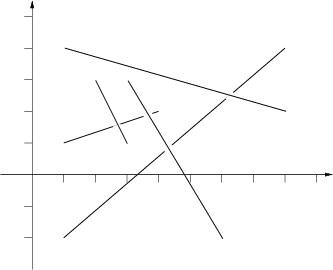标签:
题目:
Segment set |
| Time Limit: 3000/1000 MS (Java/Others) Memory Limit: 32768/32768 K (Java/Others) |
| Total Submission(s): 177 Accepted Submission(s): 82 |
Problem Description A segment and all segments which are connected with it compose a segment set. The size of a segment set is the number of segments in it. The problem is to find the size of some segment set.  |
Input In the first line there is an integer t - the number of test case. For each test case in first line there is an integer n (n<=1000) - the number of commands. There are two different commands described in different format shown below: P x1 y1 x2 y2 - paint a segment whose coordinates of the two endpoints are (x1,y1),(x2,y2). Q k - query the size of the segment set which contains the k-th segment. k is between 1 and the number of segments in the moment. There is no segment in the plane at first, so the first command is always a P-command. |
Output For each Q-command, output the answer. There is a blank line between test cases. |
Sample Input 1 10 P 1.00 1.00 4.00 2.00 P 1.00 -2.00 8.00 4.00 Q 1 P 2.00 3.00 3.00 1.00 Q 1 Q 3 P 1.00 4.00 8.00 2.00 Q 2 P 3.00 3.00 6.00 -2.00 Q 5 |
Sample Output 1 2 2 2 5 |
Author LL |
Source HDU 2006-12 Programming Contest |
Recommend LL |
题目大意:
在此对“线段集合”的概念解释一下:有A,B,C三条线段。如果A与B相交,B与C相交(线段A与线段C可以不直接相交).那么这时候A,B,C依然属于同一个线段集合。在输入样例时,遇到P代表的是添加一条新边,后面跟的是一条边的
起点的横纵坐标、终点的横纵坐标
题目分析:
计算几何+并查集。其实在这里只是用到了计算集合中的"相交"的概念,判断两条线段是否相交。大体思路就是,添加线段的时候,如果两条线段相交,就将着两条线段合并到同一个线段集合中。然后在Q的时候查询某一条
线段所在的线段集合中的线段的数量。
代码如下:
/*
* c.cpp
*
* Created on: 2015年2月28日
* Author: Administrator
*/
#include <iostream>
#include <cstdio>
#include <algorithm>
#include <cmath>
using namespace std;
const int maxn = 1001;
int father[maxn];//用于保存父子关系
int r[maxn];//用于保存一某一个结点为根节点的权重。(在这里可以理解成某一个线段集合中的点段的数量).例如r[a]表示的是以a为根节点的集合的权重
int counter;//当前的边的数量
/**
* 寻找某一个结点所在集合的根节点
*/
int find(int a) {
if (a == father[a]) {
return a;
}
return father[a] = find(father[a]);
}
/**
* 合并a结点所在的集合与结点b所在的集合
*/
void join(int a, int b) {
int fa = find(a);//找到结点a所在集合的根节点
int fb = find(b);//找到结点b所在集合的根节点
if (fa != fb) {//如果a所在集合的根节点与b所在集合的根节点不相同
father[fa] = fb;//则合并这两个集合.在这里执行的操作室将a所在集合的根节点fa指向结点b所在集合的根节点fb
r[fb] += r[fa];//将结点fa的权重加到结点fb上
/**
* 将结点fa的权重置0.为什么要这样做呢?
* 主要是为了避免权重的重复相加。这是由后面的addEdge()这个函数的执行操作所决定的。
* 每次有新的边时,addEdge()都会遍历边集合中的所有边,判断其是否与新的边相交,
* 如果相交,则执行并操作join().这时候其中一条鞭的权值就会移到另一条边上.
* 例如有序号分别为1,2,3的三条边。他们依次添加道边的集合上.它们的权重分别是1,1,1.如果这三条边都属于同一个集合,
* 那么这个集合的权重应该是1+1+1=3.
*
* 在添加边2的时候,假如边1和边2相交,那么这时候边2的权重是2
* 如果不把结点1的权重置0,那么在边3月边2、边1都相交的情况下,
* 那么经过合并操作以后,得出的并查集的权重是1+2+1=4了,这很明显是不正确的
*/
r[fa] = 0;
}
}
struct Point {//点
double x;//横坐标
double y;//纵坐标
};
struct Edge {//边
Point start;//起点
Point end;//终点
}edges[maxn];//边集合
double multiply(Point p1, Point p2, Point p0) {
return ((p1.x - p0.x) * (p2.y - p0.y) - (p2.x - p0.x) * (p1.y - p0.y));
}
//a(x1,y1),b(x2,y2)
//x1*y2-x2*y1
/**
* 确定两条线段是否相交
*/
int intersect(Edge u, Edge v) {
return ((max(u.start.x, u.end.x) >= min(v.start.x, v.end.x)) && //u中最右的点是否在v最左的点的右边
(max(v.start.x, v.end.x) >= min(u.start.x, u.end.x)) && //v中最右的点是否在u最左的点的右边
//判断这两条线段在水平层面上是否可能相交
(max(u.start.y, u.end.y) >= min(v.start.y, v.end.y)) && //u中最上的点是否在v最下的点的上边
(max(v.start.y, v.end.y) >= min(u.start.y, u.end.y)) && //v中最上的点是否在u最下的点的上边
//判断这两条线段在垂直层面上是否可能相交
(multiply(v.start, u.end, u.start) * multiply(u.end, v.end, u.start) >= 0) &&
//判断v.start,v.end是否分布在u.end两侧(或线上)
(multiply(u.start, v.end, v.start) * multiply(v.end, u.end, v.start) >= 0));
//判断u.start,u.end是否分布在v.start两侧(或线上)
}
/**
* 添加边的操作
*/
void addEdge(){
int i;
for(i = 1 ; i < counter ; ++i){//新添加的边与目前边集合中的所有边作比较
if(intersect(edges[i],edges[counter]) == true){//判断它们是否相交
join(i,counter);//如果相交则执行合并操作
}
}
}
/**
* 初始化
*/
void init(){
int i;
for(i = 1 ; i < maxn ; ++i){//遍历所有节点.索引从1开始,不要从0开始.否则会有一些问题.认真想想为什么
father[i] = i;//所有节点的父亲节点一开始默认都是它自己
r[i] = 1;//所有节点默认的权重都是1
}
}
int main() {
int t;
scanf("%d",&t);
int cas = 0;//主要用于没测测试用例后面都打印一个空行
while(t--){
if(cas != 0){//需要注意的是同样的表述.有的题目中全部打空行可以AC,有的必须最后一个不能打空行
printf("\n");
}
cas++;
counter = 1;//边数从1开始
init();
int m;
scanf("%d",&m);
string str;
int i;
for(i = 1 ; i <= m ; ++i){//需要注意一下这种形式的输入样例
cin >> str;
if(str[0] == ‘P‘){
scanf("%lf%lf%lf%lf",&edges[counter].start.x,&edges[counter].start.y,&edges[counter].end.x,&edges[counter].end.y);
addEdge();
counter++;
}else{
int index;
scanf("%d",&index);
printf("%d\n",r[find(index)]);
}
}
// printf("\n");
}
return 0;
}
(hdu step 5.1.3)Segment set(求与一条线段相交的线段集合中的线段的数量)
标签:
原文地址:http://blog.csdn.net/hjd_love_zzt/article/details/43988553